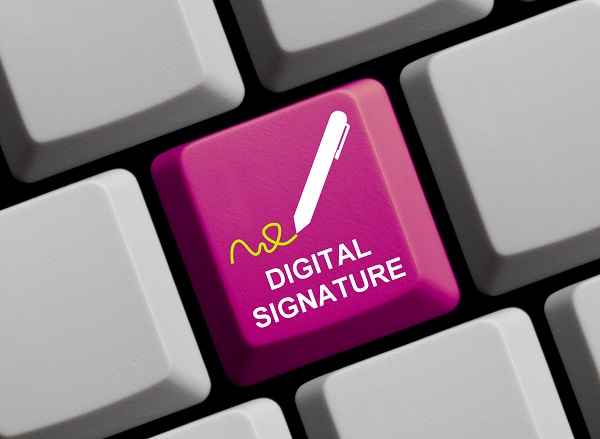If your business uses a lot of contracts and you are sending and sharing them online, you’re probably using either digital or electronic signatures. Some software programs, such as Acrobat, may represent your signature visually with a pretty cursive version of your name, but that’s not all that’s involved in the signature. The software also has a mathematical model that goes along with the signature to confirm the document was really signed by you (or at least someone with access to your software). Spoofing a digital signature is difficult, so people can comfortably conduct business around the world using electronic means. The law has also giving digital signatures the same legal significance as handwritten signatures, so if you receive a digitally signed document, you can feel comfortable that it’s just as binding.
Digital vs. Electronic Signatures
An electronic signature is when you make a mark on an electronic file that you intend to have as your signature. In some cases, this means you copy and paste in an image of your cursive signature. In other cases, it means you simply type your name or add /s. to the line with your name. Any of these can indicate that you understand you are signing the document electronically and intend to be bound. In these cases, the document often has a clause in it allowing electronic signatures. It also may be clear from the transaction itself (for example, if it’s completed completely online) that the typed name is the signature and there is an intent to be bound to the contract.
Digital signatures are slightly different in that they include a hash value generated by a mathematical formula that encrypts the document and provides confirmation for the receiver of the origin of the document. So in addition to the marking of the cursive signature or written name, there’s mathematical confirmation of the document and signature’s source.
How Do Digital Signatures Work?
A digital signature is a signature that is made electronically and also includes asymmetric cryptography to make the electronic signing difficult to spoof. It uses public-private key encryption. In short, the software creates a set of keys, one public and one private, to encrypt the message. The message is encrypted with the private key and the public key is then generated. The message and public encryption key are sent together and the public key is then used to open the file and confirm the signature. However, if even one character of the file is changed, the public key will not be able to open the file. If it is opened successfully, then the receiver of the document knows that the message was signed by the sender with their private key.
Most modern programs such as email platforms and word processing platforms have options to add a digital signature to files and you may have used these to send and receive documents that are electrically signed. You also use digital signatures online when you make a purchase or sign up for a service. Both businesses and governmental departments are moving towards using electronic signatures as it helps them have less paper overhead and makes it much easier to find the appropriate document.
If you’re interested in using electronic signatures on your documents, get the legal advice you need from the team at Virtus Law Firm by calling 612.888.1000 emailing info@virtuslaw.com. We can make sure your documents are clear that electronic signatures are allowed and that they’re collected in a way that’s binding. Using digital signatures is a great way to take a step towards having a paperless office!

